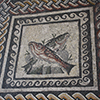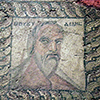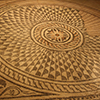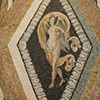Mosaics of the 4th century BC are found in the Macedonian palace-city of Aegae and they enriched the floors of Hellenistic villas, and Roman dwellings from Britain to Dura-Europos. Splendid mosaic floors are found in Roman villas across north Africa, in places such as Carthage, and can still be seen in the extensive collection in Bardo Museum in Tunis, Tunisia.
The most famous mosaics of the Roman world were created in Africa and in Syria, the two richest provinces of the Roman Empire. Many Roman mosaics are found in Tunisian museums, most of which date from the second to the seventh century AD.
The most popular subject for mosaics were mythological scenes, such as the triumps of Neptune or Dionysos, which are frequently found. The Orpheus myth (with animals) and the muses (Clio, Melpomene, Thalia, Terpsichore, Urania, Euterpe, Calliope, Polyhymnia and Erato), sometimes with the god Apollo, are also often-illustrated. Inspiration could also come from the daily life, like hunting (often with dogs), agriculture, fishing, as well as arts & crafts. Amphitheater and circus games were also a much-appreciated subject for mosaics. The four seasons and the sea (fish, the god Oceanos) are also the subject of numerous mosaics. The Seasons were illustrated like people, with a caracteristical object to identify them.
During the christian period, some subjetcs of paganism continued to be used, but some new symbols were also employed. There are nearly no biblic scenes found in Roman mosaics.
In oriental mosaics, most famous is the Zeugma mosaic, found in the Belkis museum in modern-day Turkey.












